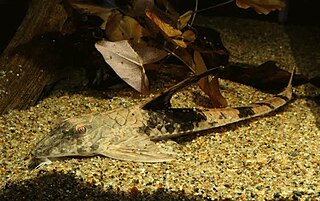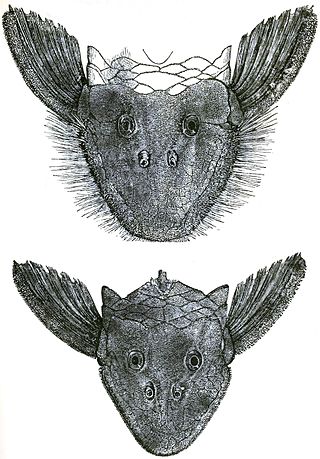
Loricariidae is the largest family of catfish, with over 90 genera and just over 680 species. Loricariids originate from freshwater habitats of Costa Rica, Panama, and tropical and subtropical South America. These fish are noted for the bony plates covering their bodies and their suckermouths. Several genera are sold as "plecos", notably the suckermouth catfish, Hypostomus plecostomus, and are popular as aquarium fish.

Hypostomus is a genus of catfish in the family Loricariidae. They are native to tropical and subtropical South America. H. plecostomus is the popular freshwater aquarium fish formerly known as Plecostomus plecostomus. The taxonomic structure of the Loricariidae is still being expanded by scientists. Hypostomus is a highly species-rich and widely distributed catfish genus.

Aspidoras is a genus of catfishes of the family Callichthyidae from Brazil.

Pseudancistrus is a genus of suckermouth armored catfishes native to South America.
Lithogenes is a genus of South American catfish of the family Loricariidae. It is the only genus within the subfamily Lithogeneinae.

Rhinelepini is a tribe of fishes in the subfamily Hypostominae of the armored suckermouth catfish family Loricariidae.

The Hypoptopomatinae are a subfamily of catfishes of the family Loricariidae, composed of 17 genera and approximately 80 species. This subfamily represents about one-tenth of all loricariid species.
Hisonotus is a genus of armored catfishes native to South America. Species of Hisonotus and Curculionichthys are the only representatives of the subfamily Otothyrinae having serrae on the posterior edge of the pectoral fin spine. These species are small fishes, generally found in small fast flowing streams, where they grasp to the branches and leaves of aquatic or subaquatic plants. The species of this genus mostly occur in Atlantic coastal streams of southern Brazil and the Paraguay-Paraná system of southern South America. They are also distributed in the Río de La Plata basin and coastal rivers of southeastern Brazil.
Harttia is a genus of armored catfishes native to South America.
Pareiorhaphis is a genus of catfish in the family Loricariidae native to South America. This genus can be readily distinguished from other neoplecostomines by the unique combination of having fleshy lobes on lateral margins of head ornamented with hypertrophied odontodes on nuptial males, caudal peduncle ovoid in cross section, abdomen usually naked, dorsal fin spinelet ovoid and adipose fin usually present. The color pattern is usually dark brown and mottled with the abdomen white. Most species in to Pareiorhaphis were originally described in Hemipsilichthys. In 1918, Alípio de Miranda-Ribeiro proposed the new genus Pareiorhaphis. Whether Pareiorhaphis is monophyletic or not is currently unknown.

Loricaria is a genus of armored catfish native to South America.

The Hypostominae are a subfamily of catfishes of the family Loricariidae. Most members are restricted to tropical and subtropical South America, but there are also several species in southern Central America. Hypostomus plecostomus, which is popular in the aquarium trade, has been introduced to several regions far from its native range.

Parotocinclus is a genus of fish in the family Loricariidae native to South America. This genus is distributed through almost all hydrographic systems in South America from the Guyana Shield drainages and Amazon Shield tributaries to the coastal drainages of eastern and southeastern Brazil, including the rio São Francisco basin. Most species have the caudal peduncle oval in cross section. It has been found that Characidium species may interact with P. maculicauda. The small Characidium will follow grazing P. maculicauda, which release particulate matter dislodged from the catfish's foraging.
Pareiorhina is a genus of armored catfishes native to South America where they are only found in Brazil. These species are known to occur at altitudes above 650 metres (2100 ft) in various rivers of the Grande, Paraíba do Sul, São Francisco and Tietê River basins. This genus was first erected by Gosline in 1947 as a monotypic genus to include Rhinelepis rudolphi. It was not until 2003 that a second species, P. carrancas, was described. The third species, P. brachyrhyncha was described in 2005. Pareiorhina forms a monophyletic subunit with Neoplecostomus within the subfamily Neoplecostominae.
Pareiorhina brachyrhyncha is a species of armored catfish endemic to Brazil where it is known from stony piedmont tributaries of the left bank of Rio Paraíba do Sul, in the State of São Paulo, southeastern Brazil. These streams belong to the Ribeirão Grande, Guameral, and Piagüi sub-drainages. They drain the southeastern slope of Serra da Mantiqueira, a major mountain range that separates the Paraíba do Sul from the upper Paraná River basin. This species grows to a length of 4.21 centimetres (1.66 in) SL.
Plesioptopoma curvidens is a species of armored catfish native to Brazil, where it is known to occur in the Rio Paraopeba, a tributary of the Rio São Francisco. It is the only species in the genus Plesioptopoma. This species reaches a maximum length of 8.3 centimetres (3.3 in) (SL).
Hirtella carinata, also known as the hairy hillstream pleco, is a species of armored catfish endemic to Brazil. It occurs in the Rio Panelão, Rio Pardo and Rio Panelinha basins in Brazil. The species reaches 4.9 cm in standard length. It is the only known member of the genus Hirtella.
Parotocinclus adamanteus is a species of catfish in the family Loricariidae. It is native to South America, where it occurs in the Paraguaçu River basin in the state of Bahia in Brazil. A phylogenetic analysis reportedly indicates that P. adamanteus is most closely related to three other species in the genus Parotocinclus: P. jequi, P. prata, and P. robustus. The species was first described in 2019 by Edson H. L. Pereira, Alexandre Clistenes de A. Santos, Mário C. C. de Pinna, and Roberto E. Reis. FishBase does not list this species.
Baryancistrus hadrostomus is a species of catfish in the family Loricariidae. It is native to South America, where it occurs in the Jari River basin. The species was described in 2019 by Renildo Ribeiro de Oliveira, Lúcia Rapp Py-Daniel, and Osvaldo Takeshi Oyakawa alongside the species Baryancistrus micropunctatus on the basis of coloration and other characteristics. Its color pattern is noted to be unique when compared with its congeners.
Baryancistrus micropunctatus is a species of catfish in the family Loricariidae. It is native to South America, where it occurs in the Jari River basin. The species was described in 2019 by Renildo Ribeiro de Oliveira, Lúcia Rapp Py-Daniel, and Osvaldo Takeshi Oyakawa alongside the species Baryancistrus hadrostomus on the basis of coloration and other characteristics. Its color pattern is noted to be similar to that of its congener Baryancistrus longipinnis, which occurs in the Tocantins River basin.








